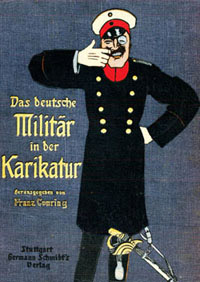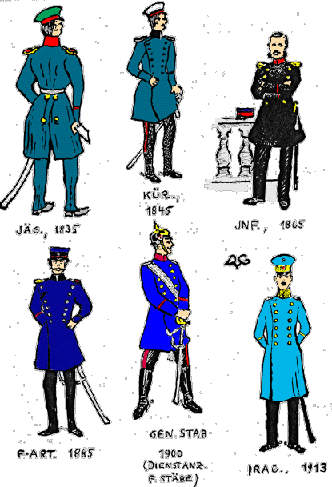Nr. 001 - "Bitte Uberrock" ; "Überrock Please".
by Frhr. v. DIEPENBROICK-GRÜTER translated of Zeitschrift für Heereskunde nov.dec.1967
Many thanks to Mr.Christofer BERTANI who sent me in november 2000 a much better English translation as mine. In fact he was probably among the last of the 2500 visitors since the begining of 2000. merci michel bas

Before 1914, one took care to add the phrase "Bitte Uberrock" (Uberrock, please) on invitations to small dinner parties in city or other simple events. Civilians came in the frock coat, and officers in the Uberrock, a simple garment reaching past the knees, with two paralell ranks of six (in Bavaria seven) flat buttons. It was also worn in the barracks, to the riding-field, to small events, to the Casino (the mess) and as walking out dress in the city. It was common to own 4 to 8 of these jackets for different services during years of service. It was the most typical officer's garment, seen daily. When one sees today officers of the "Old Army", in the theater or in movies, they are usually dressed in parade uniform - or full service or walking-out dress; that is in Waffenrock, Koller and with a lot of orders, epaulettes, and other accoutrements. One gets a false picture of the daily service or society dress of the old corps of officers.
From its origin around 1800, the Uberrock was a large coat worn over the narrow tunic of the time, the Kollett, because the Kollett was cut so short in front and on the sides that it reach only to the waist. In 1808, the Uberrock for infantry officers was prescribed to be the gray-dark general cloth, with the collar of the same color as the tunic and buttons either silver or gilt as on the tunic, but flat. Already during the war of liberation (1813) militias appreciated the Uberrock for its comfort and its moderate price - due to the absence of embroidery - which made it their single garment. Except for the Hussars, mounted officers and generals wore the Uberrock more and more, but of dark blue color - light-blue for dragoons. Of a comfortable cut, it came down past the knees; the buttons were in parallel lines sewn very close together.
 Over
time, the Uberrock became a good garment worn alone. It became more elegant,
cut closer to the body, the button ranks farther apart at the top than at the
bottom. The grey of the infantry became darker, and finally black. The long
trousers followed a similar color evolution. With the adoption of the Waffenrock
in 1843, it had to be given up, but actually it continued to be worn over the
Waffenrock until the introduction of the Overcoat in 1847. The length of the
Uberrock followed the fashions, aligning itself somewhat in length with the
civilian frock coat.
Over
time, the Uberrock became a good garment worn alone. It became more elegant,
cut closer to the body, the button ranks farther apart at the top than at the
bottom. The grey of the infantry became darker, and finally black. The long
trousers followed a similar color evolution. With the adoption of the Waffenrock
in 1843, it had to be given up, but actually it continued to be worn over the
Waffenrock until the introduction of the Overcoat in 1847. The length of the
Uberrock followed the fashions, aligning itself somewhat in length with the
civilian frock coat.
Roughly around 1880, it was very
short, bell-shaped, with ranks of buttons descending at very steep angles. It
lengthened thereafter and the ranks of buttons were parallel since 1896, moving
apart to draw attention to the chest. Until 1814, the collar was high and open,
later lower and closed, still later rounded, and at last very low. From 1890,
it was higher again, as with civilian fashions, and in 1914 the ambition of
elegant youngsters was to have a collar of 8 cm so that they practically could
not turn the head (see pictures of the Kronprinz in The UHLAN). Drawings
from the book of Paul Pietsch (page 95) show these variations. Neither Litzen,
nor braid, nor embroidery were ever known to be carried on the Uberrock. Since
1808, it was worn with shoulder cords, then from 1816 to 1830 with officer's
epaulettes. From 1830 to 1866, epaulettes were worn in service, and even by
Uhlans until 1898. Otherwise, shoulder cords have either been allowed or even
imposed since 1866. From 1898, the Uberrock only carried shoulder cords which
were sewn solidly on the sleeves. With changing fashions they became smaller
and smaller. Those of 1913 were precisely half the length and width of those
of 1905. The Uberrock for infantry, rifles (Jäger) pioneers and
generals was black until 1900. In 1903, it took the prescribed color of their
Waffenrock; that is blue (green for rifles etc.), in fact a new Prussian blue,
later a dark blue. Cuirassier and Uhlans first wore the blue Uberrock and then
a very dark blue. Dragoons first wore light-blue then horizon blue, mounted
rifles first blue in 1997, then fieldgrey in 1907. Foot artillery wore black
and field artillery blue, then after 1903 all wore the blue; the train detatchments
wore the blue after 1860. The Feldjagers ("Mounted field couriers") had
green since 1811, also the state police; the sanitary services wore black, then
blue after 1903, also the veterinarians blue since their creation in 1910.
In 1903, one saw therefore officers of the whole Prussian army - even exclusively
in some garrisons- clothed in the long dark blue Uberrock, except rifles and
policemen in green, and dragoons in light-blue. The buttons and the color of
collars alone distinguished them. Hussars always were an exception with their
attila (parade or service) colors. In plates of street scenes - officers were
not allowed to go about in civilian dress - or in service one hardly ever saw
officers in parade or full service dress. Going shooting, to the riding school,
or to exercises, officers were in Uberrock, cap and chestnut gloves.
The cavalry wore the Waffenrock (Koller or Ulanka) to exercises, but its officers - except for inspections and grand maneuvers - went there in Uberrock, with the skirts rolled-up at angles, and with the cap and chestnut gloves. The staff officers of the headquarters went to exercises in Uberrock with the helmet and the belt (general, staff officers of foot troops) or the adjutants sash (adjutant or fluegeladjutant), or belt and pouch belt (cavalry officers), all with the helmet (or the schapska etc). Otherwise the pouch belt was not worn with the Uberrock. To religious services, to concerts, the theater, visits, and dinners, the Uberrock and white gloves was similarly worn, as did spectators at the horse races, though with the cap and if possible with white trousers.
The Uberrock was never worn with a row of decorations. To dinners, visits etc., a commander's neck cross was alone permitted - for instance a cross of the 2nd class of the Red Eagle or the cross of the order of Saint-John or the Maltese order. Those awarded the lifesaving medal and war medals with black and white ribbon, wore this ribbon in the second buttonhole. Those awarded the Iron Cross 1st class wore it pinned to the chest, but no other chest decorations were allowed.
So until 1914, officers usually wore this comfortable and simple garment, being only distinguished by the colorful collar, and for the layman it was difficult to recognize which arm a given officer belonged to. Experts identified them by the regimental number or monograms on the shoulder cords. When shoulders cords were without number or missing, one could not distinguish an officer of the Line infantry, from a grenadier, or the Guard or even Garde du Corps, 6th Cuirassiers (who had a red collar by exception and not Russian blue), or uhlans (1st or 2nd regiment of the Guard, 1st to the 6th regiment of the Line). Several units wore for example an identical red collar; silver buttons, white underlay of the shoulder cords without a number: 5th Garde Rgt. zu Fuss, 1st Guard Uhlan, 4th Cuirassier Rgt., military cabinet; or perhaps; red collar, golden buttons, red underlay of the shoulder cords without number: 2nd Garde Rgt Fuss zu, Kadett School of Potsdam or Naumburg, 2nd guard Uhlan rgt, Cavalry of the Guard Landwehr.
In 1903, with the introduction of the shortLitewka jacket , the simple Uberrock in daily dress, colorful and very elegant, as achieved by master-tailors, continued to be preferred outside of the home, at the casino and the riding school. Elsewhere one continued to say "Bitte Überrock".
Complements and
commentaries
 Überrock
of a Prussian artillery officer : blue, gilt buttons, red piping, black
velvet collar (black distinctions were always in velvet on officers' garments).
The very high collar (7cm) and the two ranks of 6 very parallel buttons correspond
to the 1910 period. The lining is in black silk but the skirts at the front
edged with red piping were lined in red cloth.
Überrock
of a Prussian artillery officer : blue, gilt buttons, red piping, black
velvet collar (black distinctions were always in velvet on officers' garments).
The very high collar (7cm) and the two ranks of 6 very parallel buttons correspond
to the 1910 period. The lining is in black silk but the skirts at the front
edged with red piping were lined in red cloth.
Cuffs edged with red piping measured 19 cm according the dress regulation. They
were not sewn at the top, which allowed one to elegantly slip in a notebook
or a map. The Uberrock didn't include any visible pockets, but there were two
hidden pockets to the rear. The double-breasted front could could be worn, by
the regulation of 1899, either buttoned on the right or on the left, as both
sides are identical. Shoulder straps are sewn on the top of the shoulder seam.
Do not forget that Saxon gunners; like the Hessian dragoons, they wore a green uniform; their Überrock was therefore also green. This ¨frockcoat is for sale at Other garments
 Überrock
of Bavarian pioneer officer : the dark blue is here nearly black (very elegant)
instead of the light-blue of the Bavarian infantry uniforms. The collar is black
velvet with red piping. Pioneers and Bavarian gunners wore the same dark blue
uniform (with silvered buttons for pioneers and gilt for artillerists) with
black trousers as their Prussian counterparts. The Bavarians, who, one can say,
didn't do anything like the others, wore two rows of 7 buttons on their Uberrock
instead of 6 as on the Uberrocks of the other states. Note that the Bavarian
Chevauleger wore green jackets and Uberrocks.
Überrock
of Bavarian pioneer officer : the dark blue is here nearly black (very elegant)
instead of the light-blue of the Bavarian infantry uniforms. The collar is black
velvet with red piping. Pioneers and Bavarian gunners wore the same dark blue
uniform (with silvered buttons for pioneers and gilt for artillerists) with
black trousers as their Prussian counterparts. The Bavarians, who, one can say,
didn't do anything like the others, wore two rows of 7 buttons on their Uberrock
instead of 6 as on the Uberrocks of the other states. Note that the Bavarian
Chevauleger wore green jackets and Uberrocks.
The Bavarian
Adjutant sash (blue and silver) was 7cm wide instead
of 4.5 cm for the belt sash and the belt (see the
article on "the Adjutantur", page 14 in the UHLAN
No.6).
This garment has been sold